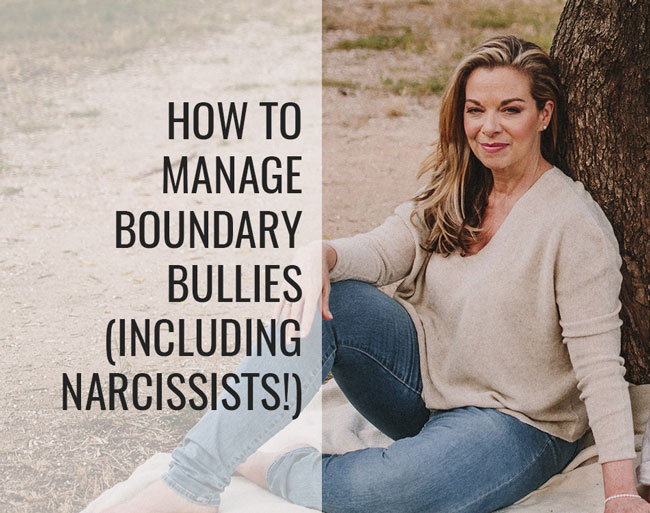Do you know any Boundary Bullies? These are people who want what they want regardless of how you feel about it. They can act in overt or covert ways to ram their agenda through. Interacting with them can be stressful and leave you feeling defeated and drained.
In today’s blog I will be covering:
- The connection between your own blueprint or past experience with boundary bullies and whom you are attracting into your life today.
- The 3 Questions to ask yourself to identify the original boundary bully
- How to Stop the Auto Yes
- How to Create Clear, Concise & Consistent Boundaries with Boundary Bullies
Those of you who are familiar with my work know that the first step to changing anything is to try to get to the root of the original injury. Your boundary bully downloaded blueprint from childhood is where we begin. During your childhood, were you allowed to draw boundaries, disagree with the majority or say no in your family of origin? Did one of your parents or caregivers dominate the others in the group? Were you encouraged to assert yourself or would differentiating result in punishment? Chaotic family systems where there was abuse, addiction, neglect or extremely high expectations for children usually do not encourage or teach healthy boundaries. But fear not, you can learn.
After you have answered the Boundary Bully questions on the downloadable cheat sheet (below), you can move onto answering the three questions to gain clarity about any boundary bully you may have in your life right now.
- Who does this person remind me of?
- Where have I felt like this before?
- Why is this behavioral dynamic, this way of interacting familiar to me?
You may be tolerating or attracting boundary bullies into your life because they deeply unconsciously resonate with you as familiar if one of your parents behaved this way. Understanding that now is not then and separating those feelings and experiences, will give you clarity on how you want to mindfully respond to boundary bullies now.
The next step in managing boundary bullies is to stop the “auto yes”. Learning how to say no when you want to helps you avoid complications down the road. To successfully get to effectively saying “No”, you can start by simply buying time by not automatically saying, “yes.” You don’t owe anyone an instant answer. If you are asked to do something that you know you don’t want to do, instead of saying yes and figuring out a way to cancel last minute, get in the habit of saying, “I will need to check my calendar and get back to you” or “My partner and I have agreed to keep Sundays for family time but thank you for thinking of us.” Eventually, as your boundary-setting skills improve, saying no when you feel no, will become easier and more natural. Realizing that you have a right to say “no” and truly believing that, is the foundation for successfully drawing this type of boundary.
Boundary bullies can be manipulative and crafty. They will play on your guilt and perhaps imply or straight up say how selfish you are for asserting your boundary or remind you of all they have done for you. Stay calm, state your simple request and restate it as many times as needed. Be sure to be clear, concise and consistent with your boundary language. Try to use “I” statements and stay away from shame, blame or guilt.
Remember that being in your life is a privilege. As you continue on your evolutionary path, you may outgrow some friendships, romantic relationships or even your job and that’s OK.
Being discerning about whom you allow into your life, creates an intentional fulfilling life! @terri_cole (Click to Tweet!)
Click here to watch the video and download the cheat sheet.
Thanks for watching, reading, and sharing!
And as always, take care of YOU.
Terri Cole is a licensed psychotherapist, transformation coach, and an expert at turning fear into freedom. Sign up for Terri’s weekly Newsletter, check out her blog and follow her on Twitter.












